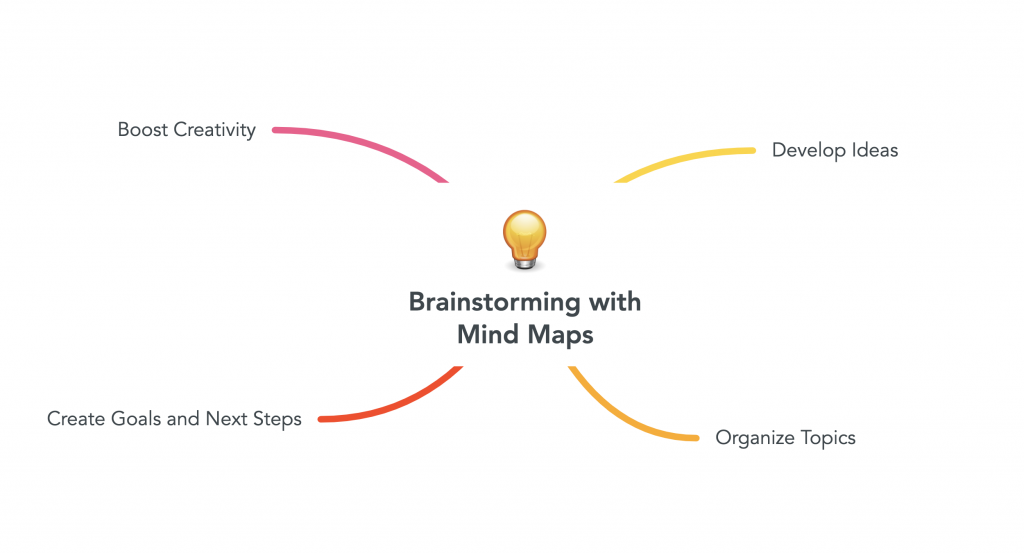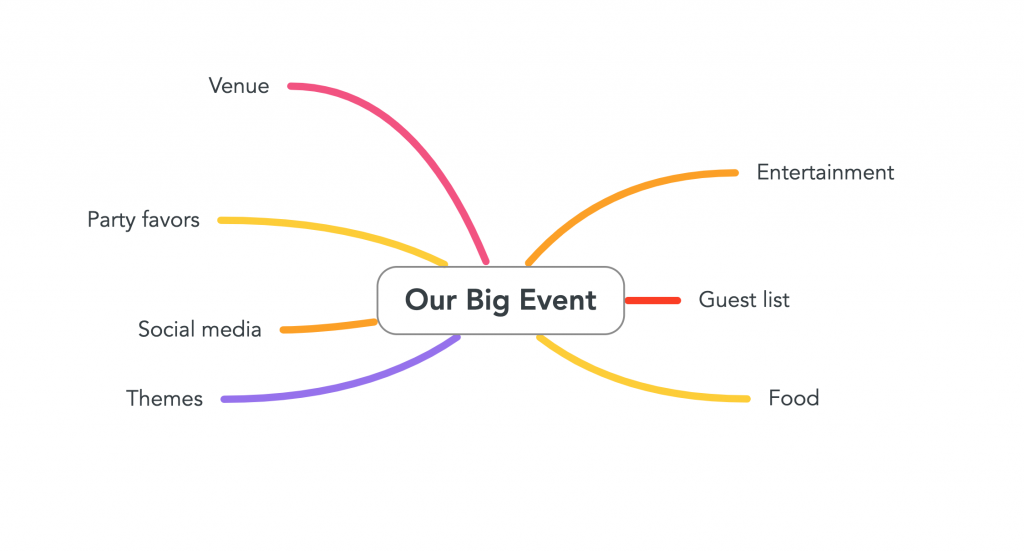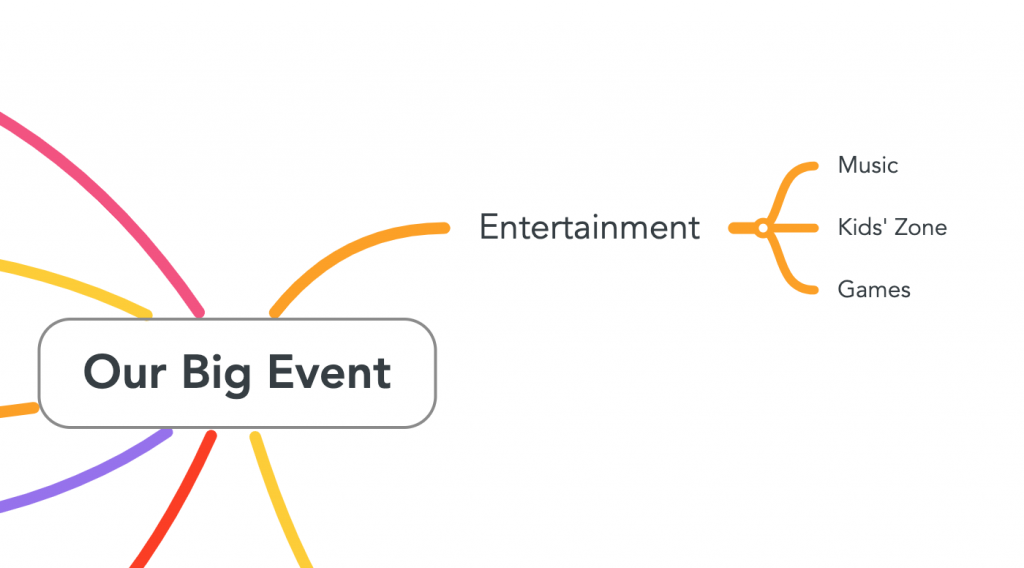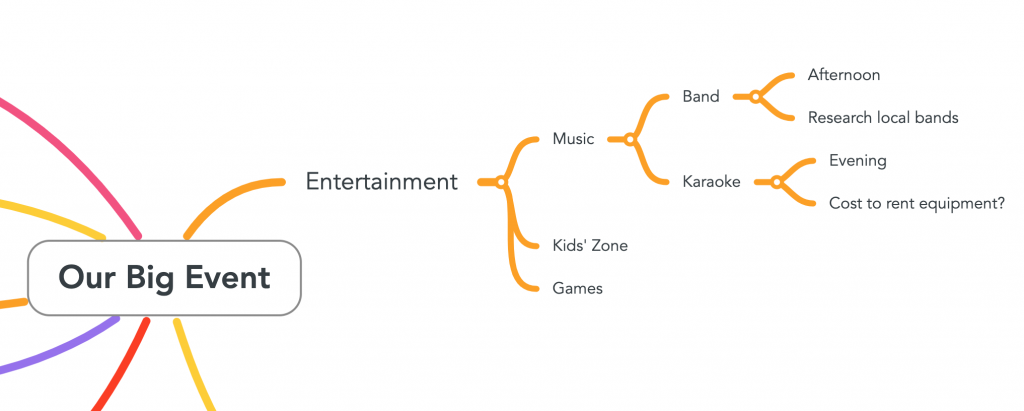Planning for More Effective Brainstorming
Brainstorming has become a buzzword used for many different purposes. It is a powerful tool to help you create and grow ideas, alone or in a group. Its power lies in the simplicity of the application, but that doesn’t mean it’s easy. So, what is brainstorming and how can you use mind maps to improve your next brainstorm? In this article, you’ll learn more about brainstorming, how to properly prepare for an effective brainstorm, and finally, why you should use mind maps for your next session.

Brainstorming 101
Brainstorming is known as a technique for generating ideas, finding solutions and solving problems. According to Alex F. Osborn, American ad executive and the father of brainstorming, “brainstorming means using the brain to storm a creative problem and to do so in commando fashion, with each stormer audaciously attacking the same objective.”
Now, you’ve probably used brainstorming for work, school, or even when planning a personal project or vacation. So you know brainstorming is an incredibly powerful tool to master. When done right, it can be effective at drawing out new ideas. When done wrong, it can be a waste of time.
Individual Versus Group Brainstorming
You can absolutely brainstorm alone. For many projects, solo brainstorming sessions are sufficient. But, if you’ve got a large or particularly difficult problem to solve, a group session may lead to better results. In a group, a large number of ideas can be generated in a short amount of time. Additionally, when you brainstorm with a diverse group, unique solutions tend to crop up because brainstorming makes it possible to productively tap a group’s creative intelligence and generative potential.
If you can’t meet with a group in person, there are several options for remote brainstorming. Using a web-based tool will allow you to collaborate with a group of people no matter where you are. There are many options for brainstorming tools that allow you to collaborate in real time. In particular, using collaborative mind mapping software allows you to work together in real time and then organize the groups’ thoughts quickly and easily. Regardless of the approach you take, whether in person or remote, you need to do a bit of advanced preparation before you get started.
Lay the Groundwork
There are a lot of best practices involved in effective brainstorming. If the right environment is created, brainstorming can be highly effective. Better planning makes brainstorming more productive. As with any endeavor, it is essential to prepare, follow a structured process, and when needed, get help from a professional.
So, how do you prepare your brainstorming session for success?
Define the Ground Rules
Effective brainstorming doesn’t limit ideas or stifle creativity with too many rules. However, it is important to outline specific guidelines to encourage individual contributions. Before the brainstorming session begins, draft some participation rules to share with the group. Here are a few rules you should include:
- Define the problem that needs to be solved.
- Implement the “Yes, and” method.
- Write down all ideas, not just the “good” ones.
- Make sure everyone shares at least one idea.
Tip:
Learn from the experts. The team at IDEO is comprised of design-thinking experts. They’ve crafted a downloadable rules sheet for your next brainstorming session.
Play by the Rules
Now, it might seem counterintuitive to have rules for a process that should be open and creative. But as Brendan Boyle, IDEO Partner and IDEO Play Lab Founder says,
“Done right, brainstorming can be amazing. It’s a lot like a game. If no one plays by the rules, it’s a disaster. But follow them and you’ll be surprised at how freeing and fruitful it can be.”
Brendan Boyle, IDEO Partner and IDEO Play Lab Founder
Rules help to provide structure so everyone knows what to expect and how to contribute. Now that the rules are in place, you’re ready to organize the next steps.
Define the Process and Tools
It is critical to get everybody involved in the process. Consider the needs of your team and organization by asking yourself: How can you get the maximum out of a meeting to spark new ideas or creative solutions? How can you give everybody an equal voice in meetings and generate ideas?
To make sure everyone has an equal voice, try using online, web-based software. A collaborative brainstorming tool, like MindMeister, can successfully help you capture individual and group contributions, whether you are in a room together or brainstorming remotely. And, mind maps allow you to visualize the thinking of all participants.
Nominate the Right Facilitator
For brainstorming to work, you need an insightful and flexible facilitator. This can be a person in your team who is nominated to lead the effort by outlining and implementing the ground rules, keeping time during the brainstorming process, and making sure that things run smoothly.
The right facilitator needn’t be a trained professional. They should have some experience with brainstorming sessions, be a good communicator, and most importantly, be unbiased. The brainstorming group needs to be guided by the facilitator, so it is essential to have a leader who is appointed within your team, or you might consider hiring an external facilitator if no internal person fits the criteria.
Invite Your Dream Team
When assembling your brainstorming group, it is important to consider what skill, expertise, or perspective each person brings to the table. The right combination of people will result in more, and often, better ideas. Not every person invited should be an ‘expert’. In fact, non-experts often bring novel ideas and perspectives to the table because they aren’t yet affected by industry knowledge or too much context.
Each member’s background is important, but it also depends on the synergy of the group. That’s why this step requires a careful selection of participants. It is vital to invite people relevant for the discussion, as the number of ideas per participant declines as group size increases.
Brainstorming with Mind Maps
Once you’ve laid the proper brainstorming groundwork, you can begin to plan your session. This process usually falls to the facilitator in collaboration with other stakeholders relevant to the topic of the brainstorming session.
The Diverge, Explore, Converge Process
There are many ways to approach this sort of creative thinking exercise, and there is no single technique for brainstorming. However, most effective brainstorming processes involve a progressive sequence of divergent (or ‘generative’), explorative, and convergent thinking.
For this next step, we are going to show you how to brainstorm in a mind map using the “diverge, explore, converge” process. Mind mapping supports all three stages of the process in one visual structure. They help you to capture, expand, and refine your thinking in one coherent and visual space.
Step 1: Diverge
The first part of a brainstorm focuses on idea generation. The goal is quantity. At this stage, we are not concerned with quality or fully formed ideas. We want to generate a volume of thoughts related to our topic, which we will bring into the next stage.
Let’s imagine we’re brainstorming ideas for a company event. If we’re using a mind map, then we’d put this as the central topic.

If you’re working alone, you can jump right into the process. Start to drop ideas into your mind map, aiming to create a big list of ideas.
To help this part of the process, you may choose to introduce other techniques to trigger creative thinking. Some examples include flashcards or word association games. You can even add trigger questions in your mind map like ‘who, what, when, where, why, and how’.

If you’re brainstorming as a group, it’s a good idea to get people working alone first. They can use sticky notes or a simple piece of paper. You don’t want them to be influenced by hearing or seeing ideas from other people. Brainstorming alone gives everyone a chance to get their original ideas clear before being influenced by others.
Step 2: Explore
After you have lots of ideas, the next step is to begin seeing if and how they fit together. At this stage, you can develop concepts further. An easy way to start this process is to categorize your ideas and see what items you can batch together.
In our event planning brainstorm, there are several ideas that could be batched together under the heading of “Entertainment”. There may be another set of items that could be batched under “Food & Drink” and so on.

Mind mapping software is excellent for this part of the process. It helps you to quickly and easily batch items together. After, you can build on ideas by either adding, moving or editing the information. Once you identify the ‘Theme’ category, related concepts are triggered and added to that category. You can use the mind map to continue to build out topics and break items down into parts. This is a crucial part of the ‘explore’ phase.
Step 3: Converge
The final step in the process ensures people come away from the brainstorm with clear priorities, goals, and next steps. Spend time determining which items should get attention, and use the mind map to identify tangible actions and next steps.
Use images or icons in your mind map to flag priority items, draw attention to ideas and prioritize to-dos. Graphics aren’t just fun. They are a practical way to enhance your mind map.
In the ‘Themes’ section of our mind map, we can start to define tasks for each topic. We could also use icons or colors to illustrate the ideas we like or don’t like.

Next Steps
After the brain dump, it’s essential to turn those ideas into action. Learning how to brainstorm with mind maps supports the creative ‘Diverge’ phase, and the more practically focused ‘Explore’ and ‘Converge’ phases. This process helps people to see the developing picture and collaboratively build on each other’s ideas and thinking. Once you’ve successfully conducted your session, make sure to follow up with next steps and deliverables. This helps keep people engaged and ensures useful work comes out of the session. Brainstorming is fun and creative, but it’s also filled with long and complicated discussions. So, make sure the discussion doesn’t stop when people leave the room.
